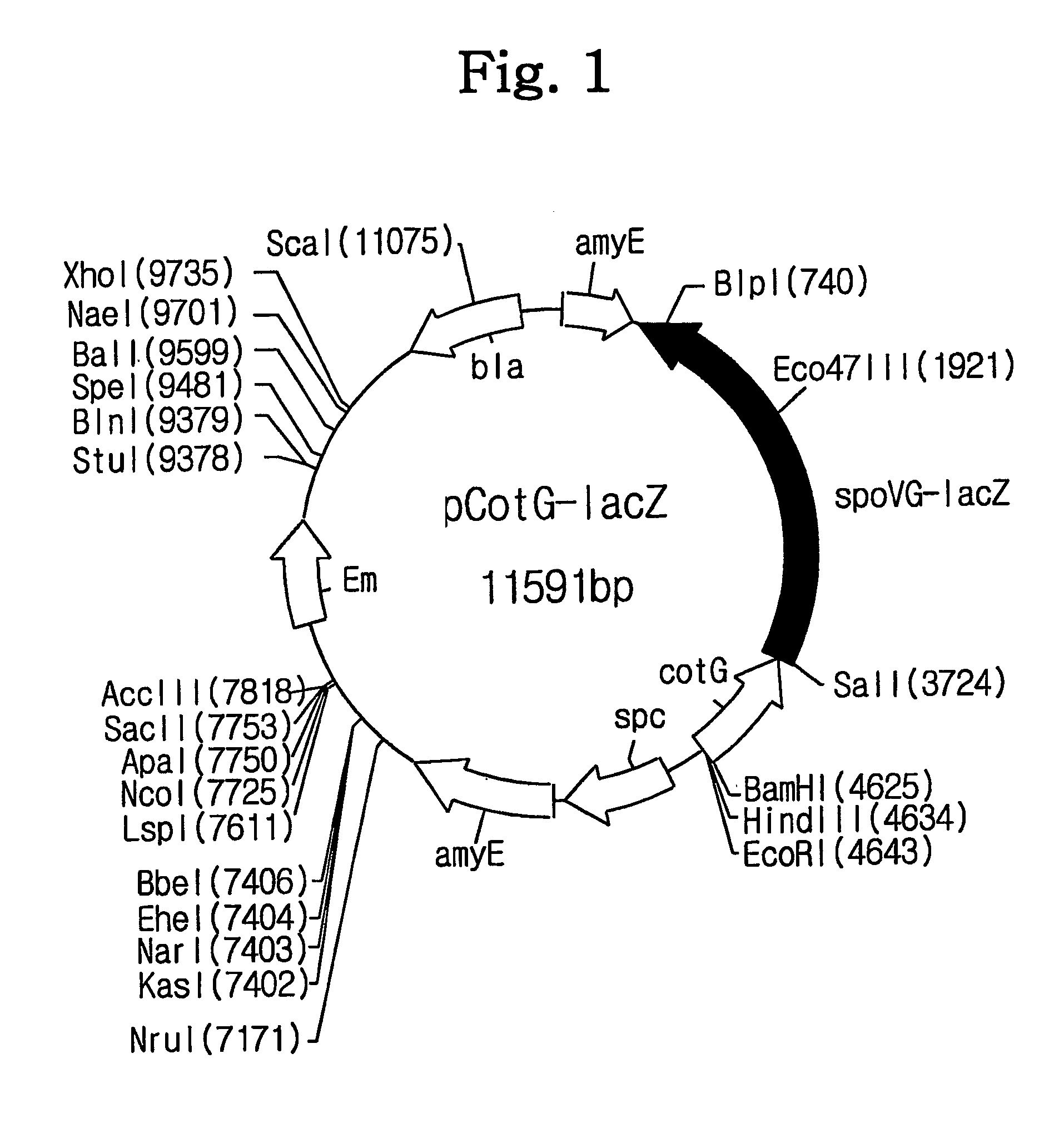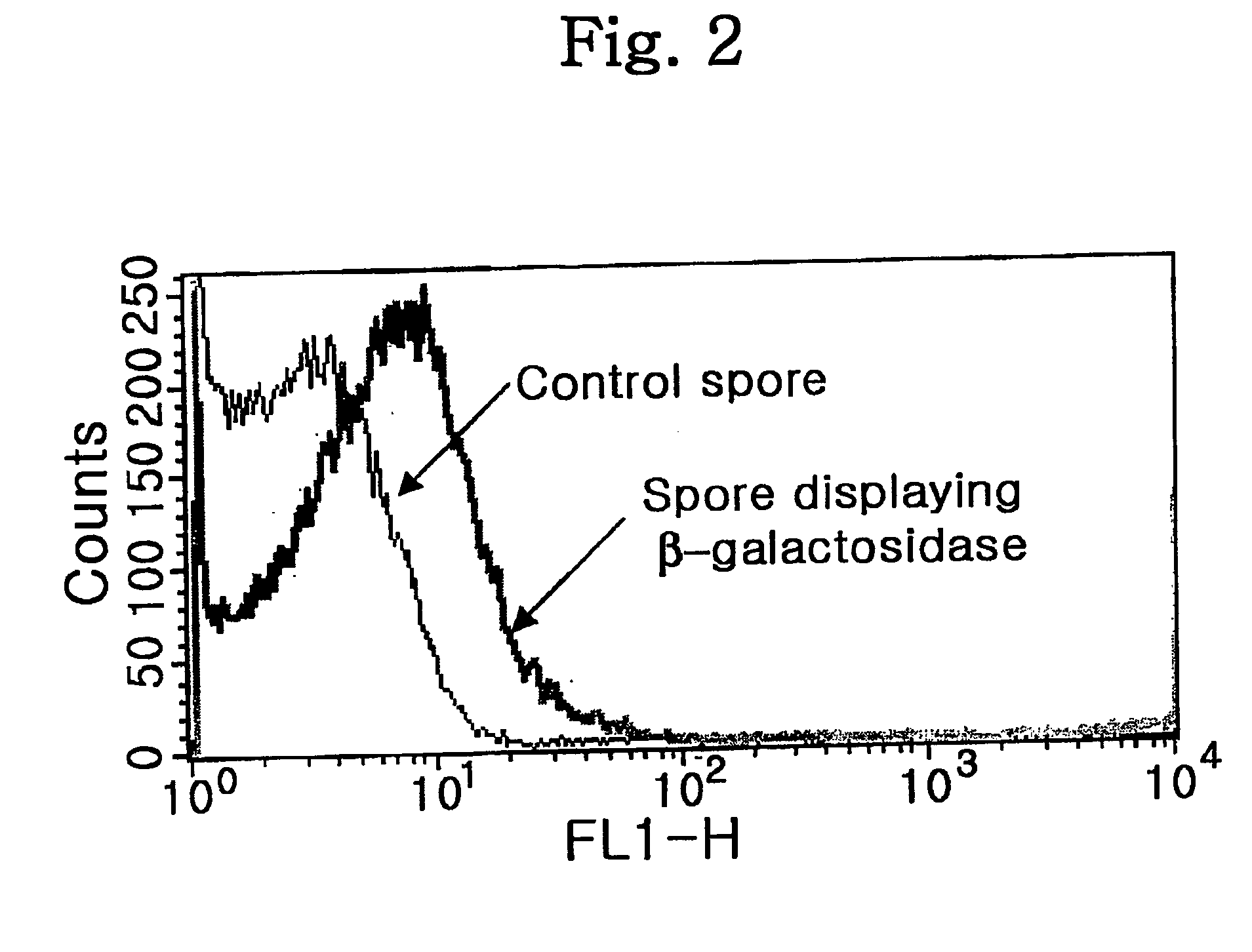Stabilized biocatalysts and methods of bioconversion using the same
a biocatalyst and bioconversion technology, applied in the field of bioconversion reactions, can solve the problems of inability to continuously reuse the whole cell biocatalyst described above, the biocatalyst is very likely to be inactivated, and the reaction of organic solvents,
- Summary
- Abstract
- Description
- Claims
- Application Information
AI Technical Summary
Benefits of technology
Problems solved by technology
Method used
Image
Examples
example i
Spore Surface-Display of Biocatalysts Fused to Coat Protein of Microbial Spore
I-1: Construction of Vector for Spore Surface-Display and Expression Thereof
[0064] A gene construct having the gene encoding a fusion protein between β-galactosidase and CotG protein which has been selected by the present inventors as the most appropriate coat protein for spore surface display among coat proteins consisting of spore (see PCT / KR01 / 02124), was constructed as follow:
[0065] To begin with, the DNA was extracted from the Bacillus subtilis 168 strain provided from Dr. F. Kunst (ATCC 23857) (13) by Kalman's method (9). The isolated DNA was served as template and 5′-primer (gcctttggatccagtgtccctagctccgag) and 3′-primer (aaaagacgtcgactttgtatttctttttgacta) of cotG were used for PCR. Taq polymerase purchased from Boehringer Mannheim was used for total 35 cycles of PCR under the condition of denaturation for 30 sec at 94° C., annealing for 30 sec at 55° C. and extension for 1 min at 72° C.
[0066] A...
example ii
Comparison of Stability Between Biocatalyst Displayed on the Surface of Spores and Biocatalyst in Free Form
II-1: Stability of Biocatalyst Displayed on Spore Surface Against Protease
[0076] While the activity of the enzymes present in Bacillus spores used in the above Example is low in comparison with that in vegetative cell, they still retain most of activities as in vegetative cell (18). Particularly, the protease present in spore is likely to degrade the biocatalysts displayed on the surface of spore, so it decreases biocatalyst stability. Therefore, the inventors measured precisely the protease activity in spores and attempted to remove such protease activity.
[0077] Protease activity was measured with EnzChek® Protease assay kit (Molecular probes). This approach permits to detect the fluorescence to occur through protease-catalyzed hydrolysis of casein labeled with fluorescein. Standard curve was obtained using trypsin available from Sigma (FIG. 3). For measuring the amount of...
example iii
Bioconversion Using Biocatalysts Displayed on Spore Surface
[0086] In this Example, bioconversion with β-galactosidase displayed on spore surface was performed as a model reaction. Such bioconversion is not limited to β-galactosidase, but, is applicable to various biocatalysts displayed on spore surface, for example, hydrolase such as lipase, protease and cellulase, oxidoreductase, transferase, lyase, isomerase, ligase and the like.
III-1: Bioconversion Using β-galactosidase Displayed on Spore Surface in Water System
[0087]β-galactosidase is an enzyme hydrolyzing lactose to glucose and galactose in water system. This enzyme is generally employed for preparation of low lactose-containing milk in the food industry. In the process employing bioconversion for food preparation, preventing the microbial contamination is so critical that heat-resistance biocatalyst is required for that purpose (21). Therefore, screening and isolating heat-resistance β-galactosidase from thermophilic micro...
PUM
| Property | Measurement | Unit |
|---|---|---|
| Fraction | aaaaa | aaaaa |
| Fraction | aaaaa | aaaaa |
| Fraction | aaaaa | aaaaa |
Abstract
Description
Claims
Application Information
 Login to View More
Login to View More - R&D
- Intellectual Property
- Life Sciences
- Materials
- Tech Scout
- Unparalleled Data Quality
- Higher Quality Content
- 60% Fewer Hallucinations
Browse by: Latest US Patents, China's latest patents, Technical Efficacy Thesaurus, Application Domain, Technology Topic, Popular Technical Reports.
© 2025 PatSnap. All rights reserved.Legal|Privacy policy|Modern Slavery Act Transparency Statement|Sitemap|About US| Contact US: help@patsnap.com



